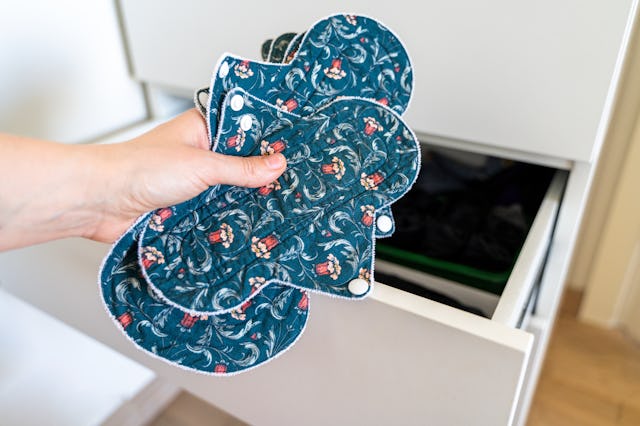New Study Finds High Levels Of Forever Chemicals In Some Reusable Menstrual Products
It’s not all bad news, but it does warrant attention...

All we wanted was to help the environment. Menstrual solutions have come a long way from our grandmothers’ sanitary belts and our mothers’ industrial strength cardboard tampon applicators. And as time has gone on, we’ve come up with a number of products that are both comfortable and reusable, so they’re good for both our fragile environment and strong-yet-delicate vaginas.
But a recent study, published in Environmental Science and Technology Letters found higher than expected levels of PFAS (per- and polyfluoroalkyl substances) or “forever chemicals” in a small sample of period and incontinence products.
Don’t panic. We’ll explain.
First, let’s talk about PFAS. These widely used, long lasting chemicals contain components which break down very slowly over time. Due to their ubiquity, they are found throughout the environment, foods, and in our bodies. Exposure to some PFAS (remember, this is a category of chemicals, not just one) may be linked to harmful health effects in humans and animals. They are largely understood to include endocrine disruptors (aka they mess with hormones) and some studies have linked them to cancer, high cholesterol, decreased fertility, low birth weight, obesity, and accelerated puberty in children.
But there’s a lot we don’t yet know, not only in regard to how exactly they can affect the human body or the environment, but also how to manage them in the environment.
“While we do know that these chemicals have been linked to serious environmental and human health issues, we do not yet know what fraction of these PFAS make it into humans by direct exposure and indirect exposure at the end of life of these products,” said Graham Peaslee, a study author whose previous research on PFAS in menstrual products contributed toward a $5 million lawsuit against Thinx period underwear.
Researchers from Indiana University and Notre Dame analyzed 59 samples — including period underwear, reusable pads, menstrual cups, reusable incontinence underwear, and a reusable incontinence pad. They opted not to mention specific brand names but shared that they were sourced from North America, South America, Australia, and Europe.
Period underwear and reusable pads were found to have the highest rates of intentional PFAS use (>110 parts per million (ppm)) at 33% and 25%, respectively. For comparison, the Biden administration was the first to really tackle PFAS in drinking water, and set the permissible standard at 4 parts per trillion. So the levels found in some of these products were considerably higher than the “acceptable” standard. (Incidentally, the Trump administration has pushed back the implementation of this regulation until 2031.)
Also, remember how forever chemicals are a category of a whole lot of different types? One distinction is “ionic PFAS (i-PFAS)” and “neutral PFAS (n-PFAS),” so-called because they lack an ionic charge. The former is easier to measure, even at extremely low levels. Researchers in this study, however, were able to measure the latter, and found them to be far more abundant in positively tested samples. At least one study has shown that n-PFAS can be absorbed through the skin.
Some samples contained levels of PFAS that were low enough to indicate casual transfer from packaging, but others were high enough to indicate that they were intentionally included, even if manufacturers didn’t realize they were there.
While this is potentially troubling, the good news is that most samples did not contain PFAS, much less at high levels. As lead author Alyssa Wicks said in a statement from Notre Dame,
“Only a subset of the products had high levels of PFAS present, which means that PFAS must not be essential in the manufacture of reusable feminine hygiene products. This is good news in that it demonstrates PFAS are not required to produce these environmentally conscious products, and manufacturers should be able to make these textile products without chemicals of concern in them.”
Again, there’s a lot we don’t yet know about PFAS. But because of this, perhaps we should learn more before we intentionally include them in products we put in our vaginas if we can avoid it... and it sure seems like it’s largely avoidable. Ultimately, researchers hope to increase thoughtfulness and transparency.
“What this study, and others to follow, can do is help consumers ask manufacturers the right question: ‘Does this product contain any intentional use of PFAS?’” said Peaslee. “Currently, there’s no labeling requirement for these products, and only a handful of U.S. states have drafted legislation requiring consumer products to be free of intentional PFAS use. This paper and others like it will help regulators and manufacturers alike to identify product markets where PFAS are being used and to find better alternatives moving forward.”